《英语翻译》课程PPT教学课件(汉英翻译)5-1 翻译的语言对比规律

cart m.cn MHP-T145A 09-10-28
cart ?
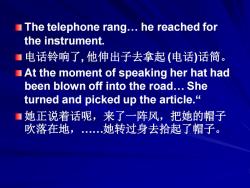
The telephone rang.he reached for the instrument. 电话铃响了,他伸出子去拿起(电话)话筒。 At the moment of speaking her hat had been blown off into the road.She turned and picked up the article." 她正说着话呢,来了一阵风,把她的帽子 吹落在地,.她转过身去拾起了帽子
The telephone rang. he reached for the instrument. 电话铃响了, 他伸出子去拿起 (电话)话筒。 At the moment of speaking her hat had been blown off into the road. She turned and picked up the article.“ 她正说着话呢,来了一阵风,把她的帽子 吹落在地,.她转过身去拾起了帽子

5 Comparative Studies of Chinese and English languages
5 Comparative Studies of Chinese and English languages

Comparative Studies of Chinese and English languages 语义的差异 ■词法的差异 句法的差异 思维的差异
Comparative Studies of Chinese and English languages 语义的差异 词法的差异 句法的差异 思维的差异
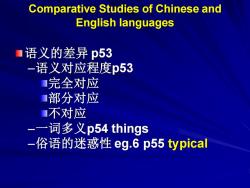
Comparative Studies of Chinese and English languages 语义的差异p53 -语义对应程度p53 完全对应 部分对应 不对应 -一 词多义p54 things -俗语的迷惑性eg.6p55 typical
Comparative Studies of Chinese and English languages 语义的差异 p53 –语义对应程度p53 完全对应 部分对应 不对应 –一词多义p54 things –俗语的迷惑性 eg.6 p55 typical
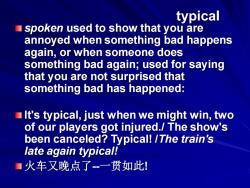
typical spoken used to show that you are annoyed when something bad happens again,or when someone does something bad again;used for saying that you are not surprised that something bad has happened: It's typical,just when we might win,two of our players got injured./The show's been canceled?Typical!/The train's late again typical! ■火车又晚点了一贯如此!
typical spoken used to show that you are annoyed when something bad happens again, or when someone does something bad again; used for saying that you are not surprised that something bad has happened: It's typical, just when we might win, two of our players got injured./ The show's been canceled? Typical! /The train's late again typical! 火车又晚点了-一贯如此!

■词法的差异 综合型语言和分析性语言p55 时态问题p56eg.8 -量词的增补p56eg.12 -语气词的增补p56eg.15 -滥用代词p57eg.16/17
词法的差异 –综合型语言和分析性语言 p55 –时态问题p56 eg.8 –量词的增补p56 eg.12 –语气词的增补p56 eg.15 –滥用代词p57 eg.16/17
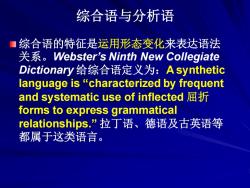
综合语与分析语 综合语的特征是运用形态变化来表达语法 关系。WVebster's Ninth New Collegiate Dictionary给综合语定义为:A synthetic language is "characterized by frequent and systematic use of inflected屈折 forms to express grammatical relationships.”拉丁语、德语及古英语等 都属于这类语言
综合语与分析语 综合语的特征是运用形态变化来表达语法 关系。Webster’s Ninth New Collegiate Dictionary 给综合语定义为:A synthetic language is “characterized by frequent and systematic use of inflected 屈折 forms to express grammatical relationships.” 拉丁语、德语及古英语等 都属于这类语言

■分析语的特征是不用形态变化而用词序及 虚词来表达语法关系。The Random House College Dictionary给分析语定义 为:An analytic language is "characterized by relatively frequent use of function words,auxiliary verbs, and changes in word order to express syntactic relations rather than of inflected forms”.汉语是典型的分析语
分析语的特征是不用形态变化而用词序及 虚词来表达语法关系。The Random House College Dictionary给分析语定义 为:An analytic language is “characterized by relatively frequent use of function words, auxiliary verbs, and changes in word order to express syntactic relations rather than of inflected forms” . 汉语是典型的分析语
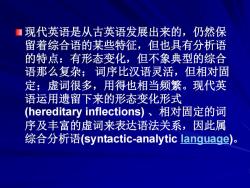
现代英语是从古英语发展出来的,仍然保 留着综合语的某些特征,但也具有分析语 的特点:有形态变化,但不象典型的综合 语那么复杂;词序比汉语灵活,但相对固 定;虚词很多,用得也相当频繁。现代英 语运用遗留下来的形态变化形式 (hereditary inflections)、相对固定的词 序及丰富的虚词来表达语法关系,因此属 综合分析语(syntactic-analytic language)
现代英语是从古英语发展出来的,仍然保 留着综合语的某些特征,但也具有分析语 的特点:有形态变化,但不象典型的综合 语那么复杂; 词序比汉语灵活,但相对固 定;虚词很多,用得也相当频繁。现代英 语运用遗留下来的形态变化形式 (hereditary inflections) 、相对固定的词 序及丰富的虚词来表达语法关系,因此属 综合分析语(syntactic-analytic language)
按次数下载不扣除下载券;
注册用户24小时内重复下载只扣除一次;
顺序:VIP每日次数-->可用次数-->下载券;
- 《英语翻译》课程PPT教学课件(汉英翻译)6 翻译的基本技巧.ppt
- 《英语翻译》课程PPT教学课件(汉英翻译)5-2 翻译的语言对比规律(词+句).ppt
- 《英语翻译》课程PPT教学课件(汉英翻译)4-2 语篇分析.ppt
- 《英语翻译》课程PPT教学课件(英汉翻译)5-1 语言对比.ppt
- 《英语翻译》课程PPT教学课件(英汉翻译)4-2 语篇分析(1/2).ppt
- 《英语翻译》课程PPT教学课件(英汉翻译)4-1 翻译单位(1/2).ppt
- 《英语翻译》课程PPT教学课件(英汉翻译)4-1 翻译单位(2/2).ppt
- 《英语翻译》课程PPT教学课件(英汉翻译)3 翻译方法.ppt
- 《英语翻译》课程PPT教学课件(英汉翻译)2-2 翻译过程(表达审校).ppt
- 《英语翻译》课程PPT教学课件(英汉翻译)2-1 翻译过程(理解1/2).ppt
- 《英语翻译》课程PPT教学课件(英汉翻译)1-3 翻译标准(2/2)、译者素质.ppt
- 《英语翻译》课程PPT教学课件(英汉翻译)1-2 翻译标准(1/2).ppt
- 《英语翻译》课程PPT教学课件(英汉翻译)1-1 翻译定义.ppt
- 《英语翻译》课程PPT教学课件(汉英翻译)新编汉英翻译 Unit 6 篇章翻译.ppt
- 《英语翻译》课程PPT教学课件(汉英翻译)新编汉英翻译 Unit 4 句子5、Unit 5 句群.ppt
- 《英语翻译》课程PPT教学课件(汉英翻译)新编汉英翻译 Unit 4 句子4.3-4.4.ppt
- 《英语翻译》课程PPT教学课件(汉英翻译)新编汉英翻译 Unit 4 句子4.2.ppt
- 《英语翻译》课程PPT教学课件(汉英翻译)新编汉英翻译 Unit 4 句子4.1.1.ppt
- 《英语翻译》课程PPT教学课件(汉英翻译)新编汉英翻译 Unit 4 句子4.1.2.ppt
- 《英语翻译》课程PPT教学课件(汉英翻译)新编汉英翻译 Unit 3 词语的翻译5/5.ppt
- 《英语翻译》课程PPT教学课件(汉英翻译)3 翻译方法.ppt
- 《英语翻译》课程PPT教学课件(汉英翻译)2-3 翻译过程之表达与审校.ppt
- 《英语翻译》课程PPT教学课件(汉英翻译)4-1 翻译单位.ppt
- 《英语翻译》课程PPT教学课件(汉英翻译)2-2 翻译过程之文化语境.ppt
- 《英语翻译》课程PPT教学课件(汉英翻译)2-1 翻译过程之理解.ppt
- 《英语翻译》课程PPT教学课件(汉英翻译)1-2 翻译标准.ppt
- 《英语翻译》课程PPT教学课件(汉英翻译)1-1 翻译定义.ppt
- 《英语翻译》课程PPT教学课件(英汉翻译)6 翻译的基本技巧 - 3/3.ppt
- 《英语翻译》课程PPT教学课件(英汉翻译)9-11 文化与翻译、忠实与叛逆、工具书的选择与运用.ppt
- 《英语翻译》课程PPT教学课件(英汉翻译)7-8 克服翻译症、文体与翻译、文化与翻译.ppt
- 《英语翻译》课程PPT教学课件(英汉翻译)6 翻译的基本技巧 - 2/3.ppt
- 《英语翻译》课程PPT教学课件(英汉翻译)5-2 翻译的语言对比规律supplement.ppt
- 《英语翻译》课程PPT教学课件(英汉翻译)4-2 语篇分析(2/2).ppt
- 《英语翻译》课程PPT教学课件(英汉翻译)5-1 翻译的语言对比规律.ppt
- 《英语翻译》课程PPT教学课件(英汉翻译)6 翻译的基本技巧 - 1/3.ppt
- 《英语翻译》课程PPT教学课件(英汉翻译)3 翻译方法.ppt
- 《英语翻译》课程PPT教学课件(英汉翻译)2-3 翻译过程之表达与审校.ppt
- 《英语翻译》课程PPT教学课件(英汉翻译)2-2 翻译过程之文化语境.ppt
- 《英语翻译》课程PPT教学课件(英汉翻译)4-2 语篇分析(1/2).ppt
- 《英语翻译》课程PPT教学课件(英汉翻译)2-1 翻译过程(理解2/2).ppt
